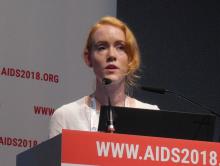AMSTERDAM – Middle-aged and elderly people infected with HIV were more likely to meet an established definition of frailty than were uninfected people of the same age, and during 4 years of follow-up frailty significantly linked with an increased incidence of both mortality and development of new comorbidities, based on a Dutch prospective study of 1,146 people.
People living with HIV also showed, despite antiretroviral treatment, a significantly increased rate of progression to frailty over the course of 4 years, compared with uninfected people, after adjustment for demographic differences. This progression to frailty appeared mediated by a high waist-to-hip ratio, a higher number of preexisting comorbidities, and symptoms of depression, Eveline Verheij, MD, said at the 22nd International AIDS Conference.
At entry into the study, people living with HIV had a 10% prevalence of frailty, compared with 3% among those who were uninfected, said Dr. Verheij, a researcher with the Amsterdam Institute for Global Health & Development. She defined frailty using criteria first introduced by researchers in 2001, which established five characteristics as markers of frailty: slow gait, low grip strength, a low level of physical activity, self-reported exhaustion, and unintentional weight loss of at least 10 pounds during the preceding year (J Gerontol A Biol Sci Med. 2001 Mar 1;56[3]:M146-57).
People with three or more of these conditions were identified as frail, those with one or two were tagged as prefrail, and people with none of these five characteristics were considered robust.
In the study reported by Dr. Verheij, the prevalence of people identified as robust at the time they entered the study was about 60% of those without an HIV infection and about 40% of those infected with HIV. During the 4 years she and her associates followed these people, their rates of progression from a robust state to frailty occurred more than twice as often among the people living with HIV, compared with those who were uninfected, after adjustment for age, ethnicity, and education.
Dr. Verheij admitted that she and her associates have not identified interventions that are effective for reversing frailty. “People who are already frail are likely to remain frail,” she noted. A better strategy is to take steps to defer frailty and help people who are robust retain that status. This could involve measures such as smoking cessation, exercise, and maintaining or expanding social networks, she suggested.
The AGEhiV Cohort Study enrolled 596 people living with HIV and 550 uninfected people who were all at least 45 years old. The average age was 52 years, with about 10% in each group older than 65 years. About 90% of the enrollees were Dutch, nearly three-quarters of those in both groups were men who have sex with men, and 14% of those who were uninfected and 20% of those living with HIV had symptoms of depression.
At baseline, 61% of those without HIV and 48% of people with HIV had no comorbidities, and while the percentage in both groups with one comorbidity at entry was nearly the same, 28% and 31%, respectively, the percentage with two or more comorbidities was more divergent. Among those without HIV infection, 8% had two comorbidities and 3% had three or more, while among those with HIV, 14% had two comorbidities and 6% had three or more.
The people living with HIV had been infected for an average of 12 years. At enrollment, 96% were on antiretroviral therapy, and those on treatment had received it for an average of 10 years. At enrollment, their average CD4 cell count was 565 cells/mm3. Their average nadir cell count had been 170 cells/mm3, and 32% had a history of being diagnosed with AIDS.
Dr. Verheij and her associates examined each participant at baseline and twice more, 2 and 4 years after enrollment. During the 4 years of follow-up, 17 people died. After adjustment for age, baseline comorbidities, and HIV infection, the mortality was more than 10-fold higher among people who had been frail at entry, compared with those who were robust.
During follow-up, 276 of all enrollees developed 329 comorbidities. The four most common incident comorbidities were hypertension, followed by chronic obstructive lung disease, renal insufficiency, and osteoporosis. These four conditions accounted for three-quarters of all incident comorbidities. After adjustment for demographics, baseline comorbidities, and HIV status, people who entered the study as frail or who became frail during the study had about a 90% increased rate of developing a new comorbidity compared with those who were not frail.
SOURCE: Verheij E et al. AIDS 2018, Abstract 9303, THAB01015.


